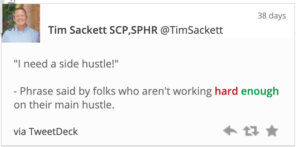You’ve probably heard it by now, the phrase “Ok Boomer!” Which blew up (cool graph showing how fast here)recently when Chloe Swarbick, a 25-year-old MP and spokesperson for New Zeeland’s Green Party. She was speaking to New Zeeland’s Parliament about climate change when she got heckled by an older member. Her response is below in the video (it happens at- :31 on the video) –
So, let me start by saying Ageism is undoubtedly a very real and serious issue we are facing in workplaces! I’ve written many posts on Ageism in hiring and selection, and I’ve witnessed hiring managers, executives, TA pros, and HR pros who show their ageism bias time and time again at organizations large and small.
The only people we hate to hire more than fat people are old people!
So, on the outset, you would feel that this is just one more form of Ageism. It’s definitely a slam and derogatory towards older thinking for sure! “Ok Boomer” is the same thing as saying “Ok Kid” when someone younger says something you think is naive at best. Chloe is talking science and she’s passionate about the climate, and she knows she’s surrounded by older members who don’t have much care for this issue.
Also, let’s put into the context of how “we” (media, speakers, leaders, trainers, etc.) basically spent the better part of a decade talking down to Millennials for believing their snowflakes (another trigger word) and not having a clue about real life. Gen Z comes along and they are just getting thrown into the Millennials bucket by most folks that don’t have a clue these are actually two very separate generations.
So, Chloe and Gen Z are fed up! When we get fed up, when we feel like no one is listening to us, we usually react in frustration and most of us say stuff that we believe will get the attention of the audience that we want to listen. Many times what we say is offensive to some, like, “Ok Boomer!” Okay, you dumb old person who won’t listen to real science and facts and you keep pissing away the future because you’re almost dead and don’t care!
I’m not a fan of name-calling, on either side. I don’t like it when we try to throw an entire generation into a bucket, because the moment you do that you meet someone from that generation that believes in the exact same things you do, and might even be doing more to fight for those beliefs than you are. Chloe knows this, but she was in a passionate speech to save her planet and some stupid person decided to interject and interrupt her and she came after them in a brilliant way to shut them down immediately and return to her speech. Go for her!
If you’re going to play the game, you better come ready, because the person you try to embarrass might come back on you in a much better way! That “Boomer” wasn’t ready and like “the kids” like to say, he got “served”! Okay, the kids haven’t said that for about a decade, but I’m GenX I basically only use historical pop culture references.

